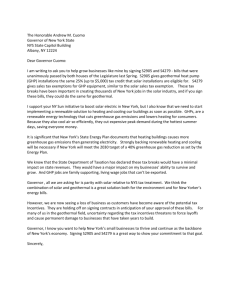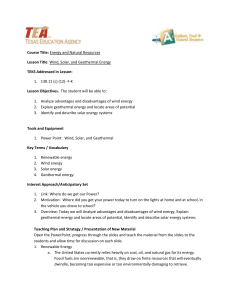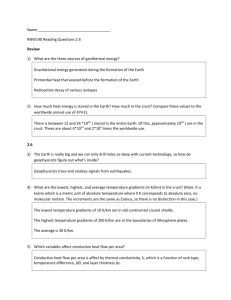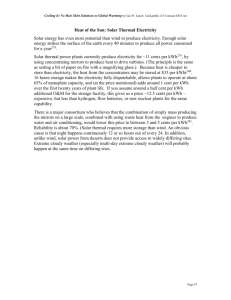renewable energy - Educational Excellence
advertisement
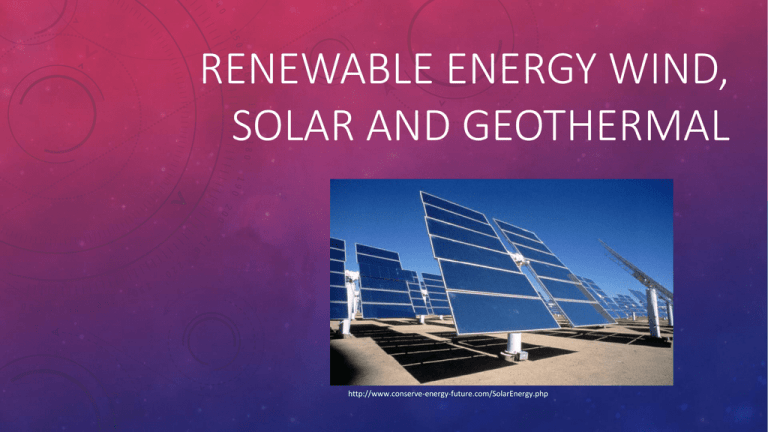
RENEWABLE ENERGY WIND, SOLAR AND GEOTHERMAL http://www.conserve-energy-future.com/SolarEnergy.php WHERE DO WE GET OUR POWER? Where did you get your power today to turn on the lights at home and at school, in the vehicle you drove to school? • Today we will: • Analyze advantages and disadvantages of wind energy • Explain geothermal energy and locate areas of potential • Identify and describe solar energy systems RENEWABLE ENERGY • The United States currently relies heavily on coal, oil, and natural gas for its energy. Fossil fuels are nonrenewable, that is, they draw on finite resources that will eventually dwindle, becoming too expensive or too environmentally damaging to retrieve. • In contrast, renewable energy resources—such as wind and solar energy—are constantly replenished and will never run out. http://www.nrel.gov/learning/ WIND • We have been harnessing the wind's energy for hundreds of years. From old Holland to farms in the United States, windmills have been used for pumping water or grinding grain. Today, the windmill's modern equivalent—a wind turbine—can use the wind's energy to generate electricity. • Wind turbines, like windmills, are mounted on a tower to capture the most energy. At 100 feet (30 meters) or more aboveground, they can take advantage of the faster and less turbulent wind. Turbines catch the wind's energy with their propeller-like blades. Usually, two or three blades are mounted on a shaft to form a rotor. http://www.nrel.gov/learning/re_wind.html PHYSICS BEHIND WIND ENERGY • A blade acts much like an airplane wing. • When the wind blows, a pocket of low-pressure air forms on the downwind side of the blade. The low-pressure air pocket then pulls the blade toward it, causing the rotor to turn. This is called lift. • The force of the lift is actually much stronger than the wind's force against the front side of the blade, which is called drag. • The combination of lift and drag causes the rotor to spin like a propeller, and the turning shaft spins a generator to make electricity. http://www.nrel.gov/learning/re_wind.html WIND ENERGY WATCH THE VIDEO TO LEARN MORE ABOUT WIND ENERGY SOLAR • Solar is the Latin word for sun—a powerful source of energy that can be used to heat, cool, and light our homes and businesses. • That's because more energy from the sun falls on the earth in one hour than is used by everyone in the world in one year. • A variety of technologies convert sunlight to usable energy for buildings. http://www.nrel.gov/learning/re_solar.html SOLAR TECHNOLOGIES • Solar Photovoltaic Technology-- These technologies convert sunlight directly into electricity to power homes and businesses. • Concentrating Solar Power--These technologies harness heat from the sun to provide electricity for large power stations. Video • Solar Process Heating--These technologies use solar energy to heat or cool commercial and industrial buildings. • Passive Solar Technology--These technologies harness heat from the sun to warm our homes and businesses in winter. • Solar Water Heating-- These technologies harness heat from the sun to provide hot water for homes and businesses. • Visit http://www.nrel.gov/learning/re_solar.html for more information about these technologies. GEOTHERMAL • Geothermal energy takes advantage of heat from the earth • This heat can be drawn from several sources: • hot water or steam reservoirs deep in the earth that are accessed by drilling; • geothermal reservoirs located near the earth's surface • There are two major types of geothermal applications • Geothermal heat pumps • Electricity production http://www.nrel.gov/learning/re_geothermal.html GEOTHERMAL HEAT PUMPS • Heat pumps work much like refrigerators, which make a cool place (the inside of the refrigerator) cooler by transferring heat to a relatively warm place (the surrounding room), making it warmer. • Geothermal heat pump systems consist of three parts: • the ground heat exchanger, the heat pump unit, and the air delivery system (ductwork). • The heat exchanger is a system of pipes called a loop, which is buried in the shallow ground near the building. A fluid (usually water or a mixture of water and antifreeze) circulates through the pipes to absorb or relinquish heat within the ground. • Watch the video on geothermal heat pumps http://www.nrel.gov/learning/re_geo_heat_pumps.html GEOTHERMAL ELECTRICITY PRODUCTION • Geothermal power plants use steam produced from reservoirs of hot water found a few miles or more below the Earth's surface to produce electricity. • The steam rotates a turbine that activates a generator, which produces electricity. • There are three types of geothermal power plants: • dry steam, • flash steam, and • binary cycle. http://www.nrel.gov/learning/re_geo_elec_production.html ACTIVITY WIND ENERGY—HOW ABOUT THOSE TRANSMISSION LINES? • Texas leads the U.S. in wind energy development, but lacks the infrastructure to develop wind energy across the state. • Conduct your own research on wind energy transmission lines and their impacts across the state. • Companies like Clean Line Energy Partners build high voltage direct current transmission lines to carry the energy across the country • Read the article. What other issues may be at play that are not mentioned? SUMMARY EVALUATION • Analyze advantages and disadvantages of wind energy • Explain geothermal energy and locate areas of potential • Identify and describe solar energy systems REFERENCES • Learning about renewable energy: http://www.nrel.gov/learning/ • Energy Basics: basics http://energy.gov/eere/energybasics/energy- • Renewable Energy Sources: http://www.eschooltoday.com/energy/renewable-energy/what-isrenewable-energy.html • Wind Energy of Texas: http://www.windenergyoftexas.com/ • Clean Line Energy Partners: http://www.cleanlineenergy.com/ COLLEGE AND CAREER READINESS STANDARDS • Social Studies I. C. 3 • Social Studies I. E. 1, 4 • Social Studies IV. A. 1, 3 Developed by the Department of Agricultural Leadership, Education & Communications, Texas A&M University for the Texas Education Agency, Educational Excellence Project for AFNR ©Texas Education Agency, 2014


